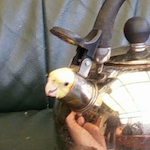|
Teketeketeketeke posted:Eh, not that fancy... When you go through the initial setup of the T-stat it should give you the option to have the backlight on 24/7 if you so desire. But yeah, using a jumper to bridge Y and G would work, we do for fixes all the time when a T-stat terminal craps out, but I'd be best to get an Add a wire or just run some new 6 or 8 conductor wire altogether.
|
|
|
|

|
| # ? Apr 26, 2024 04:02 |
|
Qwijib0 posted:Second option is theoretically legit if you don't care about fan-- thermostats just bridge the right wires to R to trigger a relay on the furnace board. Thanks! This definitely gives me a better understanding of what's actually going on. ExplodingSims posted:When you go through the initial setup of the T-stat it should give you the option to have the backlight on 24/7 if you so desire. I'll have to check the options again. I remember I could cycle through a ton of numbered options (for DST, wacky heat pump shenanigans, celsius/farenheit, etc.), so maybe lighting was one. Running wire may actually be easier than the Add-A-Wire, in hindsight - single floor home with unfinished basement ceiling 
|
|
|
|
rdb posted:My bad. I was thinking since he had both Auxiliary heat and emergency heat that it was a dual fuel type system. Although I don't know where you would put heat strips in a furnace. This is a dual fuel system, heat pump with heat strips. If you are running the heat pump and the demand is greater than the heat pump alone can accomplish the heat strips kick in and the thermostat will notify you that the heat strips have engaged by displaying some form of "aux heat". If the heat pump is broken you can set to emergency heat and only run the heat strips without trying to run the heat pump as well. They are the same thing, just different names for different applications. You can't figure out where to put heat strips on a furnace because you don't do that. To add a second form of heat to a furnace you replace the straight cool condenser with a heat pump offering the ability to run either heat pump or gas burning furnace. This is generally only done out in the boonies where people use propane for gas rather than having natural gas hookups to every house in the neighborhood and the propane heat is the backup to the heat pump. As far as nest and common go, most systems supply enough voltage through the y/w terminal to recharge the nest sufficiently during a demand for heating or cooling. Sometimes there isn't enough power present and the nest malfunctions in 1 of 3 ways: blank display due to no power, display present but absolutely nothing happens when call for heat/cool is in place, or intermittent call for heat/cool where nest sends a signal until drained and then stops until sufficiently recharged to send signal again. In the pictures that were posted it looks like there are unused blue and brown wires pushed back into the wall. Hook blue to c in the nest and hook blue to c at the air handler control board. If nest detects a wire at c, cool, if not try the brown. If still no wire detected pull new wire or get an add a wire kit.
|
|
|
|
Just saw a company-wide e-mail to salespersons reminding them about the fact that a particular cooler is not, in fact, meant to be used as a heater*. Apparently there had been a shitload of complaints from customers along the lines of "YOU'RE PRODUCT COOLING UNIT SUTSUMA 66677 DOES NOT HEAT!!!" and the product manager got a bit tired. Welp that's my HVAC story thank you, god bless you, and god bless the United States of America. *) They do put out warm air through the other end but that's coincidental.
|
|
|
|
Are the high velocity products like SpacePak any good? The AC/furnace in my house is pretty old, and very poorly installed (to give you an idea... gravity is the only thing holding the furnace onto the ductwork in the slab, you can push the furnance around whereever you want. Also, they didn't bother to cut the refrigerant lines to size, so there's tons of slack sprawling across the attic). We also know the ductwork in our house is lovely. It's all run under the slab, and I was able to get a camera down there. There's tons of raw exposed concrete and so much dust. We also have a (not-very) mysterious spot on the kitchen floor that gets either warm or cold depending on if the AC/furnace is running. I'm assuming the ductwork is a total loss, I haven't been able to find any way of fixing it short of jackhammering up the slab. I'm assuming that replacing all the ductwork with high velocity stuff would be cheaper then standard ductwork (half the house is accessible via the attic, the other half would require dropping the ceiling drywall). I'm in NJ, so heating and cooling are both requirements... I'm not sure how much a heat pump would be able to keep up. devicenull fucked around with this message at 01:26 on Aug 6, 2016 |
|
|
|
They're better than nothing. Despite the marketing, you pay a substantial efficiency cost with it, but it will at least save you from dropping soffits all over. I've only heard bad things about slab ductwork, so I'd guess you're right that it's a total loss. The other option you should consider is mini split heat pumps. It will vary quite a bit depending on your layout, but if you can cover things with a small number of heads (using ducted heads or other powered ventilation if necessary), but it can be significantly cheaper to install (ballpark $3k-$4k per head). The really good ones will work well enough in NJ to be reasonably affordable to run with electric backup heat even in a poorly insulated home, though it will still cost more than natural gas (a point source like a natural gas fireplace can offset that). And on the upside, you'll get very efficient cooling and great zoning.
|
|
|
|
Nest update. Turns out the original stat was wired wrong yet somehow worked until I disconnected it. I spent a week on the beach on Google and when I got home I tried moving the black wire to the C terminal and it fired right up!
|
|
|
|
kmcormick9 posted:Nest update. The original tstat probably had batteries in it, to keep it running even though it wasn't being powered up through C. But, anyways, HOORAY, enjoy your cold house.  And for all future Tstat installers, always check the air handler wiring first!
|
|
|
|
Just had sort of a shower thought and I figured I'd toss it out there and see how stupid it might be. Could one run the hot line of an A/C system through a cold water pipe and gain extra cooling efficiency when the water is flowing? Since the indoor part of a central air system tends to be colocated with the water heater I was thinking one could put such a system on the input side of the heater, thus using waste heat from the AC to reduce the water heater load and also eliminating the problem of surprising someone with hot water where they want/need cold if you connected it up anywhere else in the system. My A/C tends to kick on while showering or running the dishwasher for obvious reasons and I was thinking if it did something like this it might be more effective at cooling the house while simultaneously extending the time before I run out of hot water by warming the input. Of course this is purely hypothetical as well, I'm not about to go trying to re-engineer my home's water and cooling systems any time soon.
|
|
|
|
You absolutely can do that, though it does involve repiping your ac and water system. They sell heat exchangers just for that purpose, but you need to pipe them directly into the discharge line for it to get hot enough. So basically what you do is pipe straight out of the compressor, out of the condensing unit, through the heat exchanger, then back into the condenser again, and free-ish hot water is yours! The wholesale club we service foes this with their rack system, and they never even run their water heater
|
|
|
|
Many commercial buildings do this to save energy. It works great up until the point where the heat exchanger leaks and the refrigerant loop gets flooded with water. 
|
|
|
|
It's a standard feature with ground source heat pumps as well, since it's required for the Energy Star rating needed to qualify for the tax credit. It suffers from the same problem as all schemes to generate domestic hot water: residential hot water consumption is rarely high enough to justify the upfront cost of designing/manufacturing/installing a complex system. And on the rare occasion that it is, conservation is almost always more cost effective.
|
|
|
|
Clearly what we need is more expensive electricity.Zhentar posted:Oh! I forgot about heat pump water heaters. Same concept, except the "air conditioner" is built into the water heater, so you bypass the added engineering & installation overhead costs, so it ends up being more cost effective even though you double up on compressors & heat exchangers. I have one, from back when Obama was still handing out energy credits for them, and have been very happy with it. The big deal with these is you need the right climate and installation location. Like, my ac runs most of the year anyway, and it's in a conditioned area of the house. angryrobots fucked around with this message at 21:06 on Aug 16, 2016 |
|
|
|
Oh! I forgot about heat pump water heaters. Same concept, except the "air conditioner" is built into the water heater, so you bypass the added engineering & installation overhead costs, so it ends up being more cost effective even though you double up on compressors & heat exchangers.
|
|
|
|
I live in an older home (1891) here in the PNW and am tired of paying $3k/yr for electricity/baseboard heat. Due to the construction style, insulating the walls is out of the question, at least for now. There's also no room for a central air system/unit and related ducting. With that in mind, I have been looking at ductless mini split systems. The ability to provide heating/cooling from one discrete wall mounted unit makes them ideal for my situation, not to mention the relative ease of install. Does anyone have a recommendation for a site/vendor/technical resource? I would like to purchase/install the system myself if possible. For sizing, I have 6 rooms: (4) with under 200sqft, (1) with 350sq ft, and (1) with 500sqft. The house has 8ft ceilings and a ton of large windows, most with storm windows on the outside (thankfully). The two larger rooms have Vermont wood stoves. I originally looked at doing a (4) head (9-9-9-9) single compressor system for the small rooms (bedrooms/study). But now I'm thinking (2) 3 head systems, with a larger head and two smaller heads (7-7-18) I would be able to cover the larger/smaller rooms. We have a flat roof that we could easily hide the compressors on (which is important for the "look"), the downside being they would be right outside two bedrooms. The attic space is also easily accessible for cabling/tubing. Is this too little/too much? Comedy heating option: Put radiators in the bed rooms, coil behind the stove, and a pump to circulate coolant on a thermostat.
|
|
|
|
People always want to put a head in every room. It blows up your equipment cost and the install labor, and you end up way oversized in every room, so you get a ton of cycling and kill your efficiency. 6 heads for <1600sqft is ridiculous. In a completely uninsulated home, you are likely to end up with a relatively large temperature differential in rooms without a head, at least without powered ventilation, but your money & effort would be better spent air sealing and insulating to address that.
|
|
|
|
Zhentar posted:People always want to put a head in every room. It blows up your equipment cost and the install labor, and you end up way oversized in every room, so you get a ton of cycling and kill your efficiency. 6 heads for <1600sqft is ridiculous. In a completely uninsulated home, you are likely to end up with a relatively large temperature differential in rooms without a head, at least without powered ventilation, but your money & effort would be better spent air sealing and insulating to address that. I understand your point and agree that the heads are oversized, but let me explain a few things. First of all, there is already a large temperature differential in the rooms. We leave the heat on at it's minimum setting (50f) and end up going from a ~70f degree room (wood stove) to a 48f room. Second, every one of these rooms is isolated from the next via doors. The house originally had a small stove or fireplace in every room. Third. We can't reasonably add insulation to the walls. Well, rather I'm not willing to deconstruct the house to do so. (For now...) All the buildings on the property were constructed backwards- instead of going |Siding-Sheathing-Studs-Drywall| ours was built |Siding-Studs-Boards-Drywall|. If the outside of the house can not breath, water is trapped, mold forms, wood rots, ect. This eliminates pretty much all in-wall insulation. Removing the siding, installing insulation and sheathing would resolve this, but it's just not cost effective. The siding was custom milled and is $4.50 a BF to reproduce. Due to historical accuracy, we can't change it. I am planning on replacing all of the attic insulation (it's old, compacted, etc) and I bought a Flir IR camera for helping with air sealing. If there's a better option out there, I'm all ears. I'm just looking for a better way to heat the house VS paying out the rear end every winter for baseboards.
|
|
|
|
Yeah, unfortunately that's pretty typical very old house construction (they also typically make the "need to breath" thing much worse by omitting things like flashing). You can't insulate without tearing down one side of the wall, but that side can be the inside - this article covers the options well. Or if you're really desperate, you can tack a foam + drywall sandwich on top of your drywall. I understand the appeal of the quick HVAC fix, but the at the end of the HVAC -> Insulation sequencing, you end up having spent more time and money to get worse sizing compared to Insulation -> HVAC. But if you don't want to do that, you can use powered ventilation to force mixing and get one head to cover more than one room. Ducted casette mini split heads can be easily hidden in closets or small soffits and cover 2 or 3 rooms, or use can use vent fans (cheap and ugly through wall fans, or better looking ones that can be hidden in stud bays, or panasonic bath fans in the ceilings) to mix air from a room with a ductless head.
|
|
|
|
This is probably a stupid question. I have a 2 story house with a 2 story entryway and a single AC with zone control on the air handler (one upstairs, one down). I know with two separate units, you should set the upstairs a couple degrees higher than the downstairs in the summer to balance the load. What's the most efficient way to set the thermostats for my zoned single unit system? Does setting the upstairs lower than the downstairs make sense, so some of the cooled air falls to the first floor?
|
|
|
|
The most efficient way to set both to the highest temperature you are willing to. It doesn't really matter if one is higher than the other.
|
|
|
|
I have an old home with a new dual system HVAC. For the first floor I removed the Honeywell thermostat and installed a Nest. When I went to remove the thermostat from the 2nd floor system to install the next I was surprised to find that it was wireless using one of these: https://forwardthinking.honeywell.com/products/wireless/focus_pro/focus_pro_feature.html If I want to use a Nest on this one do I need to disconnect the wires from the wireless red link box and run them down to where the thermostat is mounted or is there some other solution?
|
|
|
|
OK, HVAC thread, I've got a request. I'm buying a house and the AC is 21 years old. It still blows cold, but it's obviously on its last legs and I should be lucky it hasn't disintegrated yet. The house is ~2100sqft, with vaulted ceilings in 1600 of it. Ideally, I'd like to get a full commercial-style system going, with outdoor air intake, balancing dampers, multizone with a thermostat in each bedroom and one for the livingroom/kitchen area, etc. Are these things made in non-rooftop unit form factors for residential use? If so, where do I start looking? If not, is there a way to get a system to work this way? I like the idea of being able to pull in nice, cool outside air, but don't want to have to deal with all the dirt and bugs that opening windows entails. What about humidification/dehumidification? I've got a pretty big closet for the air handler right now, so volume likely isn't a concern. Anything else I need to look out for?
|
|
|
|
Your system isn't built like a commercial setup, so there's not any simple all-in-one package that's going to get what you what you want. For fresh air intake, the best option is some sort of Heat Recovery Ventilation unit, which can reclaim heating/cooling energy from ventilation air to make it reasonably efficient year round. Some units will also support an 'economizer' option to bypass the heat exchange core when outdoor conditions are appropriate. Balancing dampers are usually an easy retrofit if you don't already have them. Per room zoning is pretty much totally unreasonable with residential central forced air. IMO, even a basic 2-zone retrofits usually don't turn out all that great; to get good quality zoning you need to design the ductwork for it from the start. If you want control down to the room, your best best is a hydronic system. For humidification/dehumidification: IMO, you should never have both. If you live somewhere humid enough that supplemental dehumidification is needed, then running a humidifier in the winter both indicates a problem with your building envelope (if it's not leaking like a sieve, it won't get super dry) and risks mold & moisture damage from condensation on/in cold building materials.
|
|
|
|
Ok, so I crawled around under the house and there's just square duct screwed to the joists above the insulation and vapor barrier. In a couple of spots, the vapor barrier is torn, so humid under-house air is condensing on the ducts, dripping off, and filling the insulation with water. So I think all new insulated ducting is in order. Everything's currently run with baseboard registers. I still want to do a multi-zone system. Do I need return registers for every zone? Currently, the air handler just pulls air in through the closet door, and that's the return for the whole house. There's a ton of room under the house. Would it be a good option to try to put a VAV in for each zone I'm setting up? I can use a central air handler on a heat pump to deliver constant-temperature air at a specific flow rate and just ramp the flow rate up or down depending zone demand, right? I still want to get some exterior makeup air for the main living space, and it looks like an "economizer" damper is easy to install in my current setup. It looks like we'll only ever need dehumidification, so that should be straightforward enough to set up.
|
|
|
|
I have a two story house with a non-programmable thermostat I'm going to upgrade. Because of the floor temp differential, I open/close registers seasonally, and sometimes run the fan just to exchange air up and down if the ac/heat isn't running very frequently. I've discovered that there are some thermostats that can use remote sensors to some effect, are there any that will sense a floor temperature differential and run the fan without heat/ac just to even things out? Or is my best bet to just use a remote sensor, set the tstat to use average temp, and let the ac run more frequently?
|
|
|
|
PerniciousKnid posted:I have a two story house with a non-programmable thermostat I'm going to upgrade. Because of the floor temp differential, I open/close registers seasonally, and sometimes run the fan just to exchange air up and down if the ac/heat isn't running very frequently. I've discovered that there are some thermostats that can use remote sensors to some effect, are there any that will sense a floor temperature differential and run the fan without heat/ac just to even things out? Or is my best bet to just use a remote sensor, set the tstat to use average temp, and let the ac run more frequently? Depending on the furnace/air handler you have you might be able to just add another dumb thermostat upstairs and connect the y/r closures to the fan terminal of your indoor unit. So a cool call from upstairs will just turn on the fan, and once the downstairs gets warm that thermostat will turn on the AC as normal.
|
|
|
|
Qwijib0 posted:Depending on the furnace/air handler you have you might be able to just add another dumb thermostat upstairs and connect the y/r closures to the fan terminal of your indoor unit. So a cool call from upstairs will just turn on the fan, and once the downstairs gets warm that thermostat will turn on the AC as normal. That's an interesting idea, but I don't know if I can fish a wire from the furnace to a reasonable thermostat location on the 2nd floor.
|
|
|
|
A couple weeks ago our downstairs thermostat started acting strange, kept switching to heat instead of cool, at first we thought the nanny was messing with it. I then saw it was running on battery power, off of ancient batteries, and it was just resetting itself. I replaced the batteries, but then realized it was running on batteries because it wasn't getting power, messed with it a bit and found that the air conditioning wasn't turning on, and couldn't get the fan to turn on either. I know just enough to be dangerous, so tried a manual override to see if the fan would turn on, no go. I've opened up the panels on the furnace to see if anything was odd in there, and it looks like there's a diagnostic LED that is off, which according to the panel means "check power." Outlets on the switch box for the furnace work fine. Anything else I should check, or should I call in a professional?
|
|
|
|
borkencode posted:A couple weeks ago our downstairs thermostat started acting strange, kept switching to heat instead of cool, at first we thought the nanny was messing with it. I then saw it was running on battery power, off of ancient batteries, and it was just resetting itself. Just for the record, is the switch on? If you know just enough to be dangerous, do you have a multimeter to check how far into the furnace the power makes it?
|
|
|
|
kid sinister posted:Just for the record, is the switch on? Yeah, switch is on (I've turned it off an on again). I do have a multimeter, but didn't try checking anything on the inside, I'll see if I can figure out which wires should be 120 volts.
|
|
|
|
borkencode posted:Yeah, switch is on (I've turned it off an on again). I do have a multimeter, but didn't try checking anything on the inside, I'll see if I can figure out which wires should be 120 volts. Sometimes people put a sensor on the condensate line, so that if it backs up the furnace turns off rather then flooding your house. I think they're usually inline with the thermostat power supply. Also you might have a switch on the furnace that kills power if the panels are off. Look for a button around the edges. Two hours of troubleshooting are responsible for me knowing both of these things.
|
|
|
|
devicenull posted:Sometimes people put a sensor on the condensate line, so that if it backs up the furnace turns off rather then flooding your house. I think they're usually inline with the thermostat power supply. Yeah, nothing on the condensate line. But I tested what I thought were the hot and neutral wires and it was only showing 1 volt, but then I realized the hot went through the panel detection switch, measured from that connector, and got the full 120 volts. I bypassed the switch and connected the board directly, and same null result from the diagnostic LED. Here's a photo of the board in case it's useful. 
borkencode fucked around with this message at 02:02 on Sep 29, 2016 |
|
|
|
Is that 5 amp fuse intact?
|
|
|
|
glynnenstein posted:Is that 5 amp fuse intact? Yep
|
|
|
|
LV transformer failure?
|
|
|
|
literally a fish posted:LV transformer failure? That sounds like it might be promising, I can check tonight, I think it should be that box on the right side there? I think that looked like a transformer. Should have snapped a photo of the circuit diagram too..
|
|
|
|
OK, just double checked, and it does look like it's the transformer. 120 volts on one side, 0.001 on the other. Here's the actual transformer.  Tried googling for the model and only found ebay links, can I just replace it with any 120->24 volt transformer?
|
|
|
|
borkencode posted:OK, just double checked, and it does look like it's the transformer. Any? If you want it to fit the 2 existing screw mounting holes, probably not any. But yeah, that sounds like you need a new transformer. edit: you did get 120v off those black and white leads feeding the transformer?
|
|
|
|
kid sinister posted:Any? If you want it to fit the 2 existing screw mounting holes, probably not any. But yeah, that sounds like you need a new transformer. Yeah, alligator clips would have made it a bit easier. I also checked the resistance across the terminals (with the leads unclipped of course) for the 120v side and got an OL.
|
|
|
|

|
| # ? Apr 26, 2024 04:02 |
|
Try to get as close to 35VA (existing rating) as possible, too. And yes, do check that you were checking white/black and white/red, not red/black and white/white
|
|
|

























